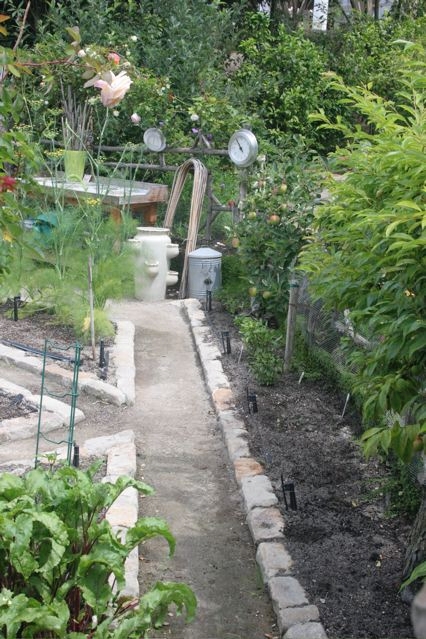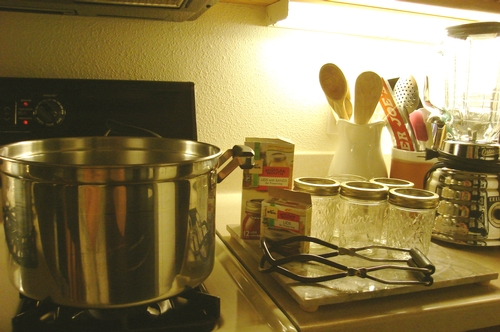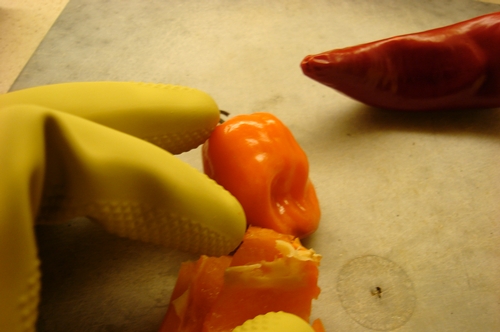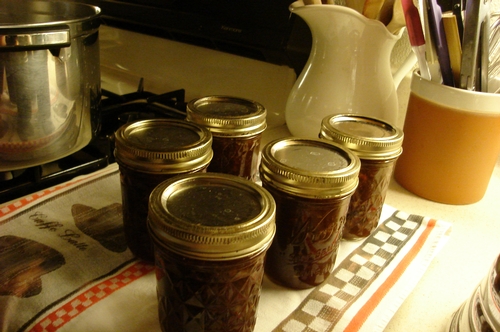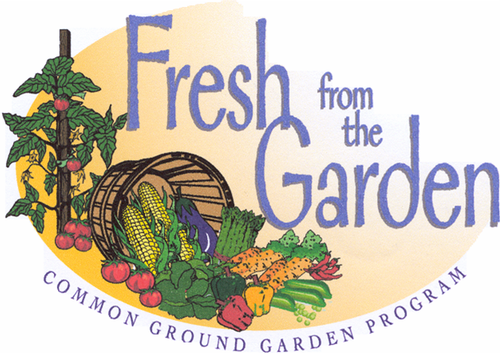Posts Tagged: gardening
Make your vegetable garden gorgeous
Vegetable and fruit gardens are taking over American backyards and that is a really good thing. However, many gardeners are forgetting that their backyard should also be a place to enjoy in other ways and hence the food garden really should be a thing of beauty as well as productivity.
I was at a garden in downtown Oakland not too long ago and the garden, while productive for being on a vacant lot, still looked somewhat like a vacant lot. You could tell there were veggies growing, chickens ran around and there were also goats on the lot but it wasn’t really a place of beauty. It looked more like a weedy lot with intermittent plots of veggies.
A beautiful vegetable garden is not difficult but it does take some planning. First, it is important to think about design. Create a garden that is pleasing to the eye with garden beds that are appropriate size for the space, and are repeated in the garden. Include walkways and paths that are clear cut and wide enough for equipment that you will use. Add elements that excite the eye such as an interesting trellis for your peas or a small bird
bath or other elements that create interest.Hide things that are not attractive with a trellis or with a screen of fruit trees. Everyone needs a place to stack up green garden refuse that needs to be chopped up for the compost pile.
Create space to sit and ponder your garden and rest in the shade. On a hot day out in the garden a little bench with some shade is a welcome respite.
Plan ahead so that you have open beds you can plant in August for your winter vegetables. So often we plant everything for summer and then August comes and we don’t have any room left for broccoli, cabbage, cauliflower, onions and garlic.
Consider color as an added element to your garden. Flowers add not only blasts of color but they also enhance the beneficial insect population. Add color to your garden by painting raised beds with colorful designs.
Add something quirky to your garden. Do you have an antique or rusted metal object that can be planted with trailing herbs or strawberries? How about hanging an old stained glass window on a tree branch or a fence. Even colorful bottles hung around the garden add interest and sound.
The key is to make your garden pleasing to the eye as well as the palate.

Pipe trellis.
Preserving summer's bounty
As we move through the summer months, backyard gardeners everywhere are faced with the questions, "What do I do with all of these [insert vegetable or fruit here]?" followed by, "What was I thinking last spring when I planted all of this?"To the rescue is a series of free, downloadable publications from the ANR Catalog. I've always noticed that these publications move to the top of our download charts each summer, so this year I decided to try one of the recipes.
This comes from the category, "What do I do with all of these peppers?" and is actually called Peppers: Safe Methods to Store, Preserve, and Enjoy. I had some dried apricots in the pantry, so I opted for the Apricot Pepper Jelly.
The ingredients are simple enough, dried apricots, peppers, apple cider vinegar, sugar and pectin.
A lot of people think making jam is complicated and requires special equipment. It's actually quite easy. If you can read and follow directions, and have good attention to keeping things clean, making preserves is a snap. The only piece of special equipment I have purchased for canning is a jar lifter. And of course you need the jars, lids and bands. Note that while the jars and bands can be used over and over, you cannot safely re-use the lids.
I wanted my jelly to have a little extra kick, so I substituted habanero for the jalapeño called for in the recipe.
When handling hot peppers, always wear rubber gloves!
After soaking the dried apricots in hot water, they are drained, then added with the peppers and the vinegar to a food processor.
This looks like it needs a couple more pulses.
Then into the saucepan it goes, along with the sugar and pectin as directed. The recipe calls for food coloring, but since that is only for appearance, I left it out.
Less than 10 minutes later, the mixture is ready to ladle into sterilized jars.
Purists probably would not call this a jelly, as it contains small bits of the apricots and peppers.
Once all the jars are filled and capped, into the waterbath they go. The recipe contains a chart of processing times based on altitude; mine is a short 10 minutes.
After the proper processing time, lift the jars out of the waterbath. Handle them carefully with the jar lifter, as they are very hot. After a few minutes out of the hot water, you will hear the ping! ping! ping! of success as the vacuum seal is made.
An initial taste test before processing revealed a piquant flavor, so I'm going to let the flavors settle in and mellow for a couple of weeks before use. I think it will taste great with goat cheese on crackers as an appetizer, or as a glaze on baked chicken.
Also in this series are similar publications for tomatoes, cantaloupe, strawberries, garlic, oranges and apples.
Victory Gardens: Join the garden revolution
Rose Hayden-Smith, Ventura County Cooperative Extension director and U.S. historian is passionate about the power and possibilities inherent in gardening. She uses her extensive knowledge of homefront war efforts to help influence public policy in regards to local food systems.
Earlier this year Dr. Hayden-Smith gave a lecture, Victory Gardens: Join the Garden Revolution, at the San Diego Natural History Museum about this topic.
More about the lecture.
At no point in our lifetimes has the interest in gardening, urban agriculture, and local food systems been so intense. It’s coming from all fronts—economic need, challenges presented by climate change, community-development needs, health and nutrition, food security, reconnecting youth with land, changing understandings of how we use space in urban areas, and a growing desire of Americans for civic engagement and participatory democracy. The past has the ability to inform the present. Review historical case studies, learn about current national policies and models, and discover the future work needed to sustain the Victory Garden model as part of the overall local food movement. Also, learn about urban agriculture and how the local food-systems movement is addressing a wide range of challenges facing Americans today.
The presentation has been archived on our website. The presentation begins approximately six minutes into the video. In addition to the inspiring message, many sources for further reading and a way to connect to the movement are available towards the end.
Learn more about victory and community gardens on Ventura County Cooperative Extension's previous related posts.
UC revives “Fresh from the Garden” materials
“Fresh from the Garden” is a “vegetable education” program that was created several years ago by retired LA County Cooperative Extension employee and registered dietitian Susan Giordano. Giordano created lessons to reach home gardeners and their families living with limited resources. The lessons are designed to increase gardeners' knowledge of healthful eating habits, while emphasizing the health benefits associated with a vegetable-rich diet. The lessons also encourage gardeners to grow a greater variety of vegetables, more nutrient-dense vegetables, to cultivate vegetable crops throughout the year, and to prepare their harvest using delicious, nutritious recipes. In recent months, the lessons have been given a makeover and updated to reflect current dietary recommendations.
Bringing nutrition education into the garden
The LA County Food Stamp Nutrition Education Program (FSNEP) is partnering with UC Master Gardener volunteers this summer to pilot the revamped lessons in the garden. A group of enthusiastic Master Gardeners with an interest in nutrition education attended a “Fresh from the Garden” training on July 10. They are now equipped to take what they learned and bring it into the low-income community and school gardens where they volunteer. Our FSNEP staff members, armed with supplemental nutrition information, plan to provide additional support and expertise along the way. This is a natural fit for UC Master Gardeners who are already teaching low-income communities how to grow their own food, and UC FSNEP staff, who are providing valuable nutrition education to food stamp-eligible families. The families who benefit from these lessons will gain the knowledge and confidence they need to enjoy delicious and nutritious vegetables fresh from the garden!
“Fresh from the Garden” tips for the gardener
This time of year, gardeners are benefiting from the fruits of their labor, however, some might be overwhelmed by the sheer volume of vegetables being produced by their gardens. What to do with it all? Below is a “Fresh from the Garden” recipe for a simple summer veggie pasta sauce. Any vegetable can be substituted, and the pasta sauce can conveniently be frozen for later use.
Summer veggie pasta sauce
|
3 – 4 large tomatoes, chopped |
1 medium small onion, chopped |
|
3 cloves garlic, crushed |
1/4—1/2 cup chopped fresh basil |
|
2 medium zucchini, chopped |
2 Tablespoons oil |
|
1 small eggplant, chopped |
Salt and black pepper to taste |
|
1 medium green pepper, chopped |
|
Heat oil in a large pan over medium heat. Add onion, green pepper and garlic. Cook for 3 to 4 minutes, stirring often. Add the zucchini and eggplant. Cook for 5 minutes.
Add the tomatoes and basil. Simmer for about 20 minutes over low heat, uncovered, until slightly thick. Add salt and pepper to taste.
This recipe can be doubled or tripled and frozen in individual or family size servings. If it is not moist enough, just add water.
Interested in accessing “Fresh from the Garden” Resources? The lessons, handouts and recipes are now available on LA County's Cooperative Extension website.
For more information about “Fresh from the Garden,” please contact Los Angeles County nutrition, family & consumer sciences advisor Brenda Roche at bkroche@ucdavis.edu, (323) 260-3299.
It's blackberry and boysenberry pickin' time
Blackberries and boysenberries are amazing fruits. The fleeting fruit bearing nature of these productive plants are to be truly appreciated by pie and jam connoisseurs alike. Berries are a very low glycemic index foods (low in sugar) and a great treat for nutritionally conscious eaters.
Every gardener can enjoy and/or hate a productive berry plant. The fruit production is confined to a very short season but the plant can take on enormous proportions if left unchecked. One must be ever diligent to keep the berry plants confined to the planting row and kept trellised to avoid the “overgrown” berry heap in the backyard. Nonetheless, if a person has a place in the sun for a four-foot-wide row of berries, the rewards are terrific.
One can even plant them on south facing wal
l as long as you can put up a sturdy supporting trellis. If you live in a very hot summer climate, it may pay to cover your berry plants with a shade cloth, especially during ripening.From one plant you can harvest enough berries for a batch of delicious jam, or a luscious pie, some fruit for breakfast and, my favorite, blackberry popsicles (recipe to follow). After harvest, cut the berry canes that have already produced fruit back to the ground and trellis up those new canes growing up from the bottom. If you do that on an annual basis, you will keep the plants under control.
There are many varieties of berries and planting several with varying ripening periods spreads the harvest out over a longer time. Many varieties have a unique flavor, different from the “wild blackberry” that you may remember from the plant growing in the ditch. Some are thornless and easier to manage and others are quite thorny but the flavor is to die for.
Berries are divided into two groups: the trailing blackberries and erect blackberries. Trailing blackberries such as Boysen and Ollalie are popular varieties that are just now becoming ripe in Northern California. I have also been growing three of the erect cultivars that require a quite tall trellis - upwards of six to seven feet. But the fruit on these types are very large, and beautiful and the plants are vigorous and disease resistant. The varieties are “Black Satin," “Triple Crown” and “Cherokee.” These varieties will become ripe in another couple of weeks.
For more information on growing blackberries in your garden, visit the California Gardening website.
While you can use the berries in many ways, one that is truly a delight is to make blackberry popsicles. Here is the recipe:
Start by making a simple syrup by heating 2/3 cup of water to boiling, pour in 2/3 cup of white cane sugar and stir until dissolved. Remove from heat and allow to cool. Put three cups of washed fresh berries into a bowl and mash. You may want to strain out the seeds by pushing the fruit through a strainer, but you don’t need to. Blend with the cooled simple syrup. (You can also just put the berries into a blender with 2/3 cup of simple syrup.)
Pour the mixture into your popsicle mold and freeze for 3 to 4 hours. Insert the popsicle sticks and freeze 3 to 4 hours more. When frozen solid, take a popsicle in hand, mosey your way out to the garden, sit in a lounge chair in the shade and lick your troubles away.


